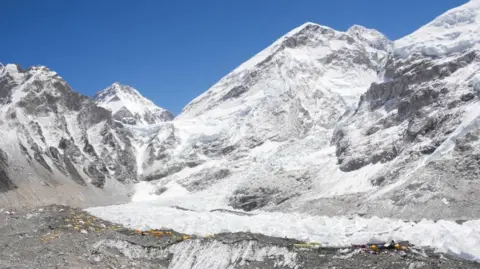Environmental correspondent, BBC World Service
 Sandro Gomen
Sandro GomenFour former British soldiers of the special forces set a record by climbing to Mont Everest in less than five days without acclimating on the mountain, as part of a high -speed expedition controversial by xenon gas.
The team, which included a Minister of the British government, invited the largest summit in the world at the beginning of Wednesday.
The xenon has been used to help them pre-acclimatize low oxygen at high altitudes. Climbers generally spend between six and eight weeks on Everest before the summit.
The organizers said that the use of Xenon had made possible such a rapid ascent. But science around the use of gas remains disputed and many people in the mountaineering industry criticized it.
Although this expedition is a record ascent of Everest without acclimating in the Himalayas is not the fastest Everest period.
This record still belongs to Lhakpa Gelu Sherpa, which went up from the base camp to the top in 10 hours and 56 minutes in 2003 – but it did it after acclimatizing on the mountain.
The team assisted by the xenon, accompanied by five Sherpa guides and a cameraman, reached the top of 8,849 meters (29,032 feet) early on Wednesday and started his descent shortly after.
“They started in the afternoon of May 16 and were heard in the morning of the 21st, taking four days and around 6 pm,” the organizer of the expedition Lukas Furtenbach told the BBC.
 Reuters
ReutersThe four former soldiers, including the Minister of Veterans Alastair Carns, slept for six weeks in special tents before going to Nepal to help them acclimatize to reduce the high altitude oxygen levels.
They then flew to the Katmandu Everest base camp and started climbing immediately, said Furtenbach. They used additional oxygen, like other climbers, during shipping.
The climbers generally spend weeks going up and down between the base camp and the upper camps before making the final push for the summit.
They need to do so to get used to the more gear oxygen levels at high mountain altitudes. Above 8,000 m, known as Death zone, the available oxygen is only a third of it present at sea level.
But the four British men of the team did nothing of this.
“The team carried out a three -month acclimatization program at simulated altitude before coming to Nepal,” said Furtenbach.
The simulated altitude was created in what is known as hypoxic tents from which oxygen is sucked in using a generator, bringing it to levels present at high mountain altitudes.
Then, the climbers inhaled xenon gas in a clinic in Germany two weeks before the expedition, said Furtenbach.
“It helps protect the body from altitude evil,” he said.
Some researchers say that xenon increases the production of a protein called erythropoetine which fights hypoxia, a condition that occurs when the body cannot obtain enough oxygen.
They say that this does it by increasing the number of red blood cells which contain hemoglobin, which transports oxygen around the body, but that remains a disputed subject and many say that other studies are necessary.
 Lukas Furtenbach
Lukas FurtenbachSome in the mountaineering industry warned against the use of xenon gas.
“According to current literature, there is no evidence that breathing in xenon improves performance in the mountains, and inappropriate use can be dangerous,” said the International Federation of Climbing and Alinism in a press release in January.
“Acclimatization to altitude is a complex process that affects the different organs / systems such as the brain, the lungs, the heart, the kidneys and the blood to different degrees, and is not entirely understood.
“From a physiological point of view, a single single drug cannot be the key to improving acclimatization or increased performance.”
Adrian Ballinger, who heads another expedition team by climbing Everest from the Chinese side to the north, also followed its pre-acclimatization customers as using hypoxic tents to shorten time on the mountains. But it opposes the use of xenon gas.
“If you are promoting Xenon as a performance implifier, but you are not also ready to examine what it means for equity and integrity in the mountains, it is a problem,” he told the BBC.
“People enter shortcuts instead of doing the real work of acclimatization and training.”
But now that the British team has made its revolutionary rise in Everest, shipping operators are thinking, and some fear that this method will also be used by other climbers.
“If this happens, it will certainly have a direct and negative impact on the tourism industry, because the duration of mountaineers will remain considerably,” said Damber Parajuli, president of the Expedition Operators Association of Nepal.
“In addition, acclimatization on the mountains is the basic rule of mountaineering. If this is not done, the authorities should not give them certifying certificates that they have climbed the mountain.”
The managers of the Nepal Tourism Department said they did not know that the British team climbed on Everest without acclimatization.
“Now that we know that, we will discuss the question and decide on our future action plan,” said Narayan Régmi, director general of the Nepal Tourism Department at the BBC.
But why climb the highest peak at such speed?
“A shorter expedition has a lower carbon footprint and less ecological impact,” said Mr. Furtenbach.
“And it’s safer for climbers because they can climb the mountain in good health and they are exposed to high altitude risks and mountain risks for a shorter time compared to the moment when they acclimatize on the mountain.”



